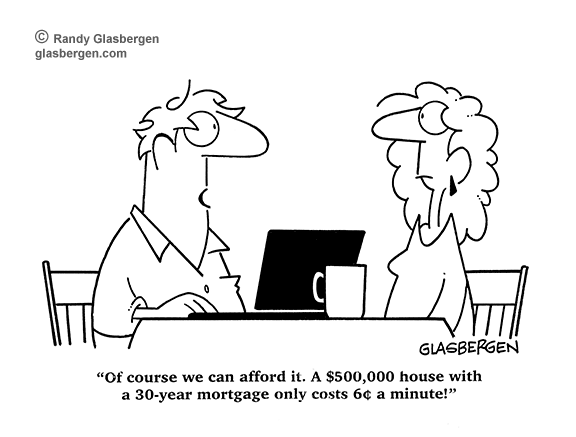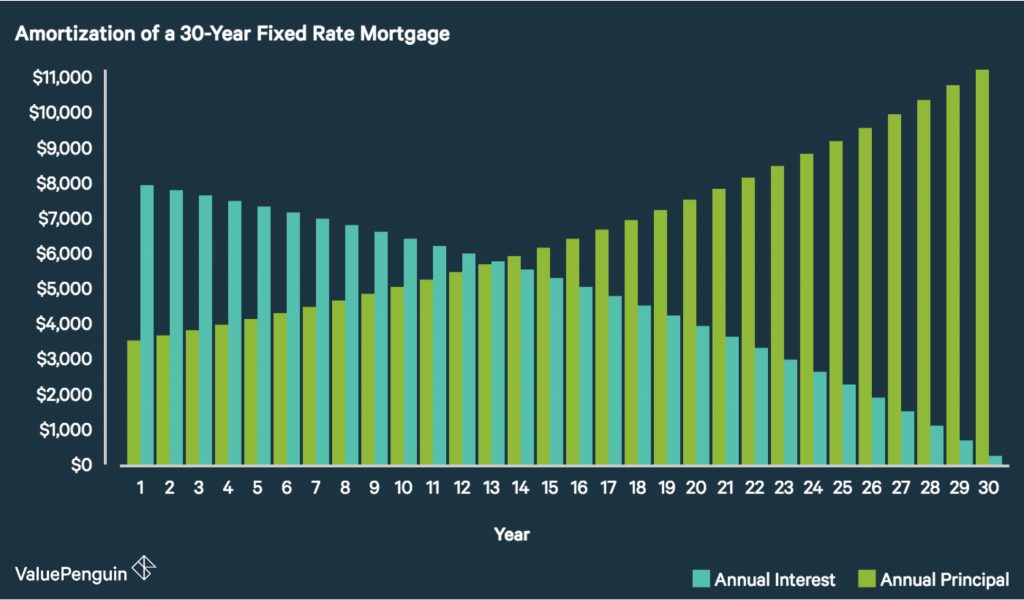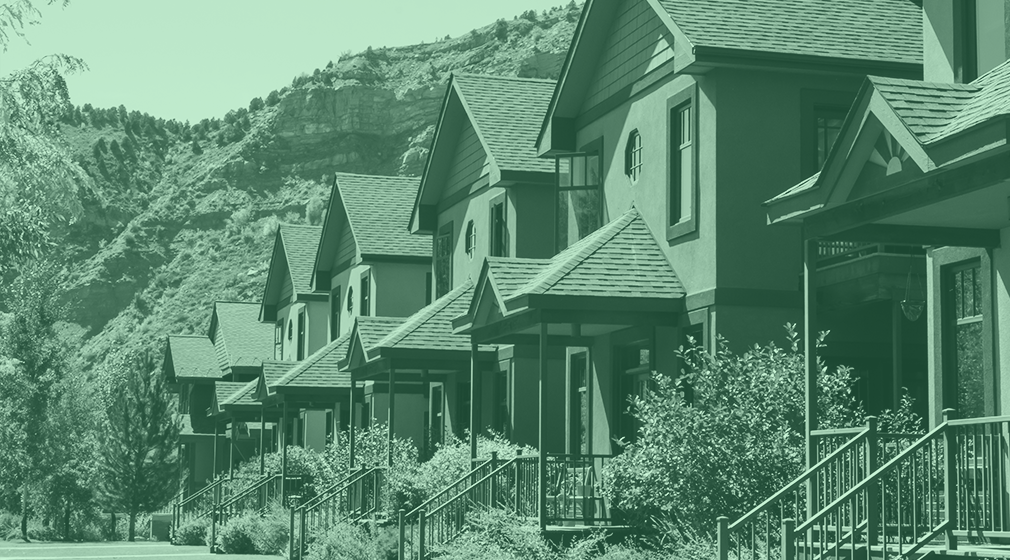The 30-Year Fix (Pt. 1): The Curious Case of the 30-Year Fixed-Rate Mortgage in America

In any complex industry, macro transformation happens slowly. In the mortgage industry, evolution is so subtle that it’s nearly impossible to spot as it occurs, visible only through the 20/20 lens of hindsight.
And yet even in hindsight, the 30-year fixed-rate mortgage — and our unwavering loyalty to it — remains largely unchanged over the last century.
Our dedication to the 30-year mortgage may not feel abnormal, but zoom out and examine the mortgage landscape from an international perspective and suddenly, the American mortgage market begins to stand out for its unique reliance on the thirty-year fixed-rate mortgage.
Welcome to The 30-Year Fix, our three-part series on the curious case of the thirty-year fixed-rate mortgage (or TYFRM, for the sake of brevity) in America. In this series, we will cover the history of the TYFRM in America and examine why we are so uniquely reliant on it in the United States. Part 1 will cover the history and context of the TYFRM and examine how we might be outgrowing it.
Part 2 will look at how (and why) mortgage products evolve in different nations, looking at mortgage products around the world to consider why certain mortgage products are favored in different economies.
Finally, in Part 3, we will dig deeper into the TYFRM from the lender’s perspective and examine the TYFRM’s inextricable link to government-sponsored entities (GSEs) to tease out what the future might look like as GSE reform gets underway.
_________
The birth of the thirty-year, fixed-rate mortgage
As we’ve touched on in our previous series, “A Crack in the Foundation”, the modern mortgage market emerged in the 1930s, in part due to the establishment of Fannie Mae in 1938 and the role of the FHA in developing and standardizing the fixed-rate mortgage as an alternative to the balloon payment mortgages common during the early 20th century.
Before that, 55% of all Americans were renters, and those that did own homes typically had mortgages with five-year terms. Because balloon mortgages relied on a large, lump-sum payment at the end of the mortgage term, borrowers would typically refinance each time their term was up. This worked well… until the Great Depression hit banks hard, hindering their ability to refinance these balloon mortgages. Many borrowers were suddenly unable to pay their balloon payment or find a bank to give them a loan for it. And so we saw a mortgage finance crisis in 1932 with widespread foreclosures across the nation.
But along came FDR’s New Deal plans to rebuild the economy, housing market included. He established the Home Owners’ Loan Corporation to buy failing mortgages and convert them into longer loans (that included interest and principal).
Additionally, the FHA was created to insure mortgages against default and set quality standards; with this came 15-year loan terms.
“And then basically the FHA kind of keeps pushing it to 20 years, and then 25, and then 30,” said Andra Ghent, who teaches real estate finance at the University of Wisconsin-Madison.
Mortgage myth will tell you that the TYFRM boomed from the 1930s on when it actually was a bit slower to take root. From the 1930s to 1960s, average loan terms were still well under 30 years and averaged around 21 years from 1946 to 1954. The thirty-year loan term was not even authorized by Congress until 1948 for new construction and 1954 for existing homes.
Regardless, this shift to longer loan terms was great for borrowers. The introduction of the fixed-rate mortgage by the FHA in the 1930s marked the first mortgage product in the U.S. that was fully amortized with fixed interest rates and payments. These fixed-rate mortgages, combined with loan programs with lower down payments, helped raise homeownership rates from 43.6% in 1940 to 61.9% in 1960.
Unfortunately, the thirty-year mortgage didn’t make quite as much sense for lenders. After all, lenders don’t pay fixed-interest rates to depositories. The longer the loan term, the more lenders were exposed to risk.
To compensate for this, Congress created Fannie Mae and Freddie Mac to buy and guarantee these mortgages so lenders could take the risk off of their books. Over time, these government-sponsored entities (GSEs) wrapped lenders in their proverbial security blanket and helped them cozy up to the idea of the thirty-year fixed-rate product (more on this in Part 3).
For a long time, this formula worked. The TYFRM, propped up by GSE securitization, stimulated homeownership and cemented it in the American psyche as a prosperous wealth-building vehicle. And for a time, it was. Housing prices were artificially cheap until the ‘70s/’80s, and homeowners saw steady home price appreciation which reinforced beliefs that investing in a home (with leverage) is a quick way to build wealth.
But we need to remember that being a homeowner — in the sense of having a mortgage— does not actually equate to owning a home. The more debt you have and the less means you have to service that debt, the more you’re just a highly leveraged real estate speculator.
The 30-year mortgage as a wealth-building vehicle
TYFRMs are often touted as being good for borrowers, but are they really as good as we think?
Frank Nothaft, chief economist at Freddie Mac, says that homebuyers continually flock to the thirty-year fixed-rate mortgage because of affordability, stability, and flexibility.
“That means the monthly payments are lower than on a 15-year mortgage, which is fundamental to making homeownership viable for first-time buyers in their early earning years,” Nothaft writes on Freddie Mac’s website. “Moreover, by avoiding payment shock and negative amortization, fixed-rate borrowers are less likely to fall behind on their payments, – a plus for investors too.”
But others, like Alex J. Pollock of the American Enterprise Institute, argue that common sentiment about the TYFRM has morphed to overstate its benefits and under-emphasize its flaws. And the inextricable link between GSEs and the mortgage market is a key reason why.
Pollock says:
“Discussions of housing finance give a shining religious aura to 30-year fixed-rate mortgages. They are the last refuge of the defenders of Fannie Mae and Freddie Mac, who argue that we have to have government guarantees so we can have 30-year FRMs. First, this argument is wrong. Second, the 30-year FRM is not the unmitigated blessing the Fannie and Freddie loyalists imply. Indeed, it is a big reason U.S. mortgage markets are in such bad shape.”
Americans have indeed been socialized to believe that homeownership — and by association, the TYFRM — is the fastest vehicle for building wealth. And when times are good, that holds true. When interest rates and house prices alike rise, borrowers reap the benefits of a static mortgage payment despite rising interest rates and get to keep the whole inflationary premium in the house prices.
But when interest rates plummet and home prices fall, the cracks in the veneer of the TYFRM begin to show.
In an economic downturn, the TYFRM stops being such a reliable wealth-building vehicle. The TYFRM becomes less lucrative when the market shifts because it simply does not help borrowers build home equity quickly enough.
For a concrete example, a $150,000 30-year fixed-rate mortgage at 4.5% interest will put you at a monthly payment of around $760 (not including taxes or insurance). Of that $760, $560 of it goes toward interest for the first year of your loan. On the other end, less than $35 a month will be paid toward interest over the last year of your loan.
Tl;Dr (the internet version of ‘to make a long story short’), this means the borrower is essentially just renting their home from the bank for the first several years.
Considering that the average homeowner in 2019 lives in their home for just eight years, falling short of staying even a third of their mortgage term, this does not seem like a peak ‘wealth-building’ setup for the borrower. Unlike with renting, you have to pay to maintain and repair your home. So not only are you building equity at a glacial pace but you’re also in the hole for upkeep expenses you wouldn’t have to pay for as a renter.
Homeowner by choice, investor by accident
One of the most fundamental drawbacks of the TYFRM is that it forces average Americans to operate like financial investors. The mortgage industry is complex and the information asymmetry between lenders and borrowers is essentially structured to encourage borrowers to make bets they don’t fully understand.
After all, the mortgage loan is essentially a bet that hinges on several factors. It’s a bet on the value of a specific home: a bet that you won’t destroy your home and (hopefully) will invest in it to improve its value. A mortgage is also a bet on local real-estate prices (which, by extension is a bet on local labor markets). After all, what dictates rent prices is the availability and median wage of jobs (case in point: San Francisco).
And finally, it’s a bet on interest rates. If a company borrows money for 30 years, they can often pay it back at any time, but if rates have dropped (raising the present value of the bond), they’ll have to pay it back at a premium. But mortgage borrowers have the option to refinance if rates move to their advantage, but can keep the mortgage if rates rise.
“But this contradicts what you were just arguing about the 30-year fixed-rate mortgage,” you may be thinking.
Not exactly. The TYFRM does give borrowers an embedded advantage to insulate themselves from interest rate risk, and that is indeed an upside (and also why the TYFRM is fundamentally a risky financial instrument for lenders). The issue is that the structure of our current system forces borrowers to make a bet they don’t even understand, and it’s a bet that doesn’t help them quite as much as they’ve been led to believe.
As economist Byrne Hobart argues:
“Owner-occupied housing is mostly consumption, with a little investment layered on top. You don’t see consumers hedging their exposure to gas prices by making elaborate bets on WTI futures, or investing in royalty trusts. You don’t see financial advisors telling bacon lovers to hedge their next thirty years of breakfast consumption with a rolling long position on lean hogs. Only in residential real estate do we tell people to behave this way. But given the correlation between residential real estate and local labor markets, and the declining geographic mobility of Americans… this is actually the last risk we should hedge this way.”
For the average American, their biggest asset is the net present value of their future wages. And it’s hard to hedge against future income. A TYFRM is a bet by borrowers that their income will stay relatively stable, but the nature of the product intrinsically encourages borrowers to borrow more than they should, spend more money than they can afford, and pay more interest than they need to.
 And thus we have more and more borrowers who are over-leveraged and can’t build equity fast enough to make their 30-year bet as lucrative as they believed it would be.
And thus we have more and more borrowers who are over-leveraged and can’t build equity fast enough to make their 30-year bet as lucrative as they believed it would be.
The amortization of the 30-year mortgage is so slow that it is nearly twice as risky as a similar loan with a 20-year term, and a 30-year loan compounds the risk-layering by promoting the use of higher combined loan-to-value and debt-to-income ratios. Just because your monthly payments are lower does not mean that the 30-year mortgage makes homeownership more affordable.
Indeed, as Edward J. Pinto argues, it actually makes housing more expensive:
“Since 2012, lower priced entry-level homes have risen by about 55%, while move-up homes have risen by about 31%. This means lower priced entry-level homes that cost an average of $103,315 in 2012, cost a whopping $160,138 in late-2018. Thus, rather than making housing more affordable as its supporters claim, 30-year loans make housing less affordable.”
Is the 30-year mortgage holding us back?
And this is all just touching on the borrowers’ perspective, which, if you’ll recall, is often the main reason cited for the TYFRM’s enduring popularity.
It seems that borrowers have been lured into thinking a TYFRM is the right choice partly because it is the most familiar, and the most commonly selected by their friends and family.
But beyond that, it’s comfortable. The familiarity and enduring presence of the TYFRM in our mortgage market makes borrowers feel a little less intimidated about the daunting complexity of the mortgage process. It represents ‘business as usual’ and the way things have (literally almost always) been.
And yet, in so many ways, we’ve simply outgrown the thirty-year fixed-rate mortgage.
American society looks far different than it did back in the heyday of the thirty-year fixed-rate mortgage. In 1960, 68% of twentysomethings were married; in 2008, that number was just 26%. The average age of a first-time homebuyer in 1960 was 24 to 25; in 2018, the average first-time homebuyer was 34. And don’t forget the burden of student loan debt which impacts millennials and their parents’ generations alike.
Borrowers have fundamentally changed, as have the sources and logistics of their income. If TYFRM is, to a degree, a bet on the borrower’s income not changing, that’s fundamentally incompatible with the realities of our gig economy.
So why haven’t we adapted our financial products to complement these dramatic shifts in market dynamics and borrower realities?
For lenders and borrowers alike, the thirty-year fixed-rate mortgage makes less and less sense the more you dig into the details. We’ve evolved too far for the TYFRM to adequately keep up, and changes must be made to fix this problem that’s almost a century in the making.
With GSE reform perpetually on the horizon, it’s important to consider the arrested development of our mortgage product mix relative to our economic and sociocultural evolution since the 1930s. And it’s even more important to identify how GSEs have, in part, been structured to keep us coming back for more of a product that some would argue is intrinsically toxic.
The U.S. is one of the only countries in the world to have a 30-year fixed mortgage loan, with France and Denmark as the only notable exceptions. It may seem like we’re stuck in our ways, and it’s because we are.
But there are options out there that can be better for borrowers and lenders both, and Part 2 of this series looks into the successful mortgage products around the world and consider why certain products resonate in different economies.
Read Part 2: Mortgage Products Around the World >>>
___________
Sources
“A Timeline of Mortgage History in the United States. | Brad L’Engle.” Accessed September 23, 2019. https://www.lenglemortgageprofessionals.com/a-timeline-of-mortgage-history-in-the-united-states/.
Adams, Kristen. “Homeownership: American Dream or Illusion of Empowerment?” SSRN Scholarly Paper. Rochester, NY: Social Science Research Network, December 13, 2009. https://papers.ssrn.com/abstract=1467896.
Almenberg, Johan, Annamaria Lusardi, Jenny Säve-Söderbergh, and Roine Vestman. “Attitudes Toward Debt and Debt Behavior.” Cambridge, MA: National Bureau of Economic Research, August 2018. https://doi.org/10.3386/w24935.
———. “Attitudes towards Debt and Debt Behaviour.” VoxEU.Org (blog), October 27, 2018. https://voxeu.org/article/our-changing-attitudes-towards-household-debt.
“Alternative View: The Dutch Mortgage Market from an International Perspective.” Aegon AM. Accessed September 18, 2019. https://www.aegonassetmanagement.com/global/investment-solutions-center/publications/the-dutch-mortgage-market-from-an-international-perspective/.
“You Have To Understand Germany’s Long-Standing Fear Of Debt.” Business Insider. Accessed September 9, 2019. https://www.businessinsider.com/you-have-to-understand-germanys-long-standing-fear-of-debt-2012-7.
“Average Homeowners Stay 8 Years Before Moving.” Realtor Magazine, May 3, 2019. https://magazine.realtor/daily-news/2019/05/03/average-homeowners-stay-8-years-before-moving.
Badarinza, Cristian, John Y Campbell, Gaurav Kankanhalli, and Tarun Ramadorai. “International Mortgage Markets: Products and Institutions,” n.d., 15.
Bernhardsson, Erik. “Why I Went into the Mortgage Industry.” Erik Bernhardsson, February 17, 2017. https://erikbern.com/2017/02/17/why-i-went-into-the-mortgage-industry.html.
Buckley, Robert M. “Housing Finance in Developing Countries: The Role of Credible Contracts.” Economic Development and Cultural Change 42, no. 2 (1994): 317–32.
Burnett, Victoria. “A Job and No Mortgage for All in a Spanish Town.” The New York Times, May 25, 2009, sec. Europe. https://www.nytimes.com/2009/05/26/world/europe/26spain.html.
Fabozzi, Frank J., and Franco Modigliani. Mortgage and Mortgage-Backed Securities Markets. Harvard Business School Press Series in Financial Services Management. Boston, Mass: Harvard Business School Press, 1992.
Fernández de Lis, Santiago, Saifeddine Chaibi, Jose Félix Izquierdo, Félix Lores, Ana Rubio, and Jaime Zurita. “Some International Trends in the Regulation of Mortgage Markets: Implications for Spain.” Madrid, Spain: BBVA Research, April 2013. https://www.bbvaresearch.com/wp-content/uploads/mult/WP_1317_tcm348-384510.pdf.
“From Main Street to King Abdullah Financial District: Lessons Learned in International Mortgage Finance.” RiskSpan – Data Made Beautiful (blog), July 12, 2018. https://riskspan.com/news-insight-blog/lessons-learned-in-international-mortgage-finance/.
Gudell, Svenja. “A Glimpse at Life Without the 30-Year Fixed-Rate Mortgage.” Forbes. Accessed September 9, 2019. https://www.forbes.com/sites/zillow/2018/03/06/a-glimpse-at-life-without-the-30-year-fixed-rate-mortgage/.
“Here’s How Muslim Buyers Get around the Mortgage Interest Problem—but It’s Tough in NYC.” Brick Underground, February 22, 2017. https://www.brickunderground.com/buy/muslim-friendly-mortgages.
Hobart, Byrne. “The 30-Year Mortgage Is an Intrinsically Toxic Product.” Medium, January 18, 2019. https://medium.com/@byrnehobart/the-30-year-mortgage-is-an-intrinsically-toxic-product-200c901746a.
“Housing Finance Fact or Fiction? FHA Pioneered the 30-Year Fixed Rate Mortgage during the Great Depression?” AEI, June 24, 2015. http://www.aei.org/publication/housing-finance-fact-or-fiction-fha-pioneered-the-30-year-fixed-rate-mortgage-during-the-great-depression/.
“In China, a Three-Digit Score Could Dictate Your Place in Society.” Wired. Accessed September 9, 2019. https://www.wired.com/story/age-of-social-credit/.
Kagan, Julia. “Balloon Mortgage.” Investopedia. Accessed September 23, 2019. https://www.investopedia.com/terms/b/balloon-mortgage.asp.
McLean, Bethany. “Opinion | Who Wants a 30-Year Mortgage?” The New York Times, January 5, 2011, sec. Opinion. https://www.nytimes.com/2011/01/06/opinion/06mclean.html.
“Mortgage Loans Around the World.” The Finance Buff, September 29, 2008. https://thefinancebuff.com/mortgage-loans-around-the-world.html.
“New Bubble May Be Building in 30-Year Mortgages.” AEI, December 23, 2011. http://www.aei.org/publication/new-bubble-may-be-building-in-30-year-mortgages/.
Nguyen, Jeremy, Abbas Valadkhani, and Russell Smyth. “Mortgage Product Diversity: Responding to Consumer Demand or Protecting Lender Profit? An Asymmetric Panel Analysis.” Applied Economics 50 (July 21, 2018): 4694–4704. https://doi.org/10.1080/00036846.2018.1459038.
Osborne, Hilary. “Islamic Finance – the Lowdown on Sharia-Compliant Money.” The Guardian, October 29, 2013, sec. Money. https://www.theguardian.com/money/2013/oct/29/islamic-finance-sharia-compliant-money-interest.
“(PDF) Mortgage Product Diversity: Responding to Consumer Demand or Protecting Lender Profit? An Asymmetric Panel Analysis.” Accessed September 18, 2019. https://www.researchgate.net/publication/323994918_Mortgage_Product_Diversity_Responding_to_Consumer_Demand_or_Protecting_Lender_Profit_An_Asymmetric_Panel_Analysis.
Rodima-Taylor, Daivi, and Parker Shipton. “BOSTON UNIVERSITY LAND MORTGAGE WORKING GROUP RESEARCH REPORT • 03/2017,” n.d., 72.
Rodríguez-Planas, Núria. “Mortgage Finance and Culture.” Journal of Regional Science 58, no. 4 (September 2018): 786–821. https://doi.org/10.1111/jors.12385.
Stoykova, Polina, and Linjie Chou. “Housing Prices and Cultural Values : A Cross-Nation Empirical Analysis,” 2013.
“The 30-Year Fixed Mortgage Should Disappear.” AEI, April 26, 2016. http://www.aei.org/publication/the-30-year-fixed-mortgage-should-disappear/.
“The Challenge of Building Affordable Housing in Developing Countries … and How DFIs Can Help | OPIC : Overseas Private Investment Corporation.” Accessed September 9, 2019. https://www.opic.gov/blog/opic-in-action/the-challenge-of-building-affordable-housing-in-developing-countries-and-how-dfis-can-help.
“The Risky Mortgage Business: The Problem with the 30-Year Fixed-Rate Mortgage.” AEI, December 11, 2012. http://www.aei.org/publication/the-risky-mortgage-business-the-problem-with-the-30-year-fixed-rate-mortgage/.
“What’s So Special about the 30-Year Mortgage?” AEI, February 1, 2011. http://www.aei.org/publication/whats-so-special-about-the-30-year-mortgage/.
“Why Do We Have a 30-Year Mortgage, Anyway?” Marketplace (blog), October 31, 2018. https://www.marketplace.org/2018/10/31/why-do-we-have-30-year-mortgage-anyway/.
“Why the Universal Use of the 30-Year Mortgage Is Dangerous.” AEI, April 22, 2019. http://www.aei.org/publication/why-the-universal-use-of-the-30-year-mortgage-is-dangerous/.




